1997 CHEVROLET BLAZER load capacity
[x] Cancel search: load capacityPage 118 of 402

Downloaded from www.Manualslib.com manuals search engine NOTICE:
Loading cargo that weighs more than 200 lbs.
(91 kg) on the luggage carrier may damage your
vehicle. When you carry large things, never let
them hang over the rear or the sides
of your
vehicle. Load your cargo
so that it rests on the
slats and does not scratch or damage the vehicle.
Put the cargo against the side rails and fasten it
securely to the luggage carrier. Put the main
weight as far forward as you can.
Don’t exceed the maximum vehicle capacity when
loading your vehicle. For more information
on vehicle
capacity and loading, see “Loading Your Vehicle”
in
the Index.
To prevent damage or loss of cargo as you’re driving,
check now and then
to make sure the luggage carrier and
cargo are still securely fastened.
Ashtrays and Cigarette Lighter
To use the lighter, press it in all the way, and let go.
When it’s ready, it will pop back by itself.
NOTICE:
~~~ -~ - ~
Don’t hold a cigarette lighter in with your hand
while it
is heating. If you do, it won’t be able to
back away from the heating element when it’s
ready. That can make it overload, damaging the
lighter and the heating element.
The front ashtray must be completely pulled out to the
open position before the ashtray cover opens and
smoking material can be deposited.
2-6 1
Page 138 of 402
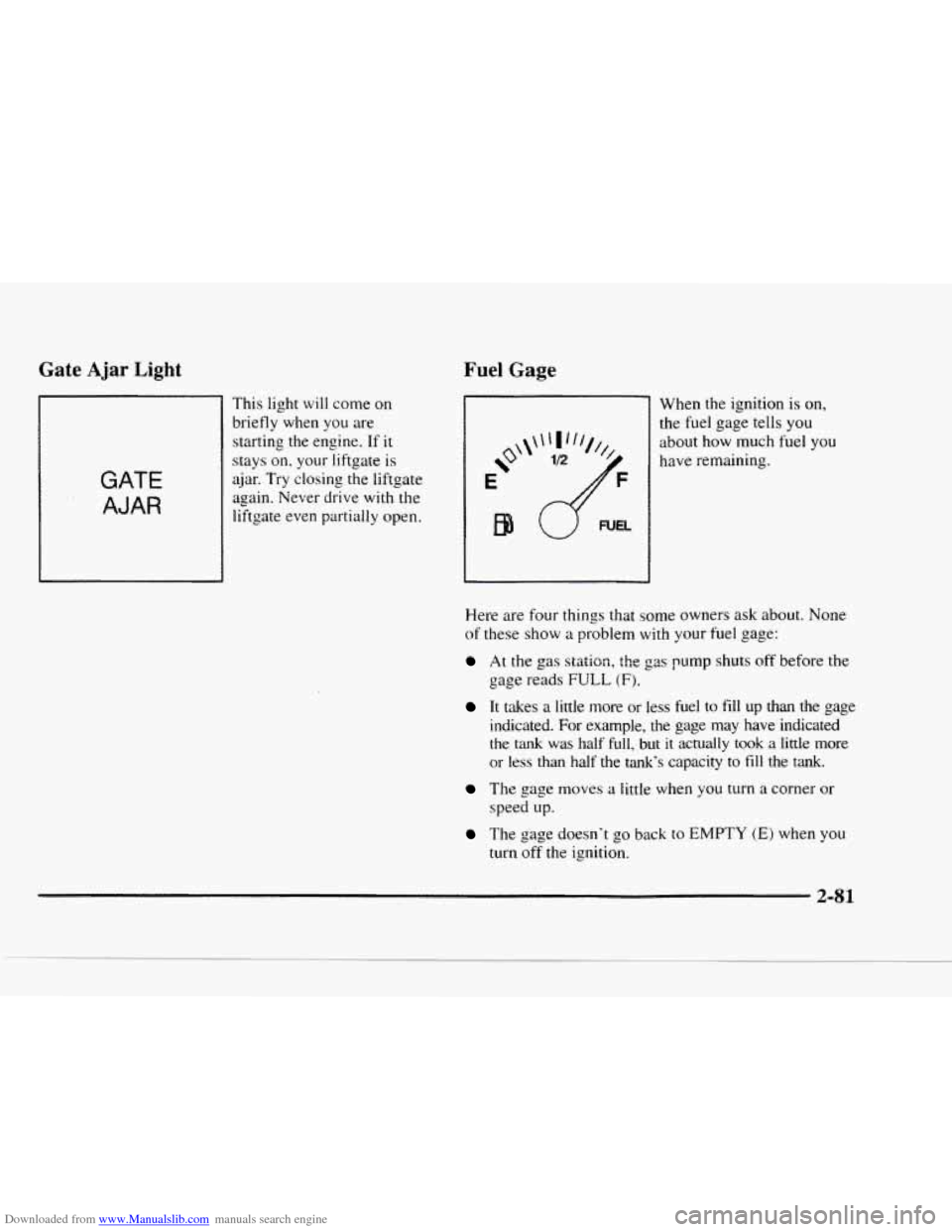
Downloaded from www.Manualslib.com manuals search engine Gate Ajar Light
GATE
AJAR
This light will come on
briefly when you are
starting the engine. If
it
stays on. your liftgate is
ajar. Try closing
the liftgate
again. Never drive with the
liftgate even partially open.
Fuel Gage
When the ignition is on,
the fuel gage tells you
about how much fuel
you
have remaining.
Here are four things that some owners ask about. None
of these show a problem with your fuel gage:
At the gas stsiion, the ga rump shuts off before the
gage reads FULL (Fj.
It takes a little more or less fuel to fill up than the gage
indicated.
For example, the gage may have indicated
the tank was half full, but it actually took a little more
or less than half the tank’s capacity to
fill the tank.
The gage moves a little when you turn a corner or
speed up.
The gage doesn’t go back to EMPTY (E) when you
turn
off the ignition.
2-81
Page 203 of 402

Downloaded from www.Manualslib.com manuals search engine Recreational Vehicle Towing (Except Four-wheel Drive
With
Manual Shift Transfer Case) Loading
Your Vehicle
Vehicles
with two-wheel drive or the optional electronic
shift transfer case require special modifications before
they can be towed in this manner. Please contact your
dealer
for the towing information that is appropriate for
your particular vehicle.
Vehicles with all-wheel drive
(AWD) can not be towed
in this manner.
The Certificationflire label is found on the driver’s door
edge, above the
door latch. The label shows the size of
your original tires and the inflation pressures needed to
obtain the gross weight capacity of your vehicle. This is
called the
GVWR (Gross Vehicle Weight Rating). The
GVWR includes the weight of the vehicle. all occupants,
fuel, cargo and trailer tongue weight, if pulling a trailer.
4-42
Page 205 of 402
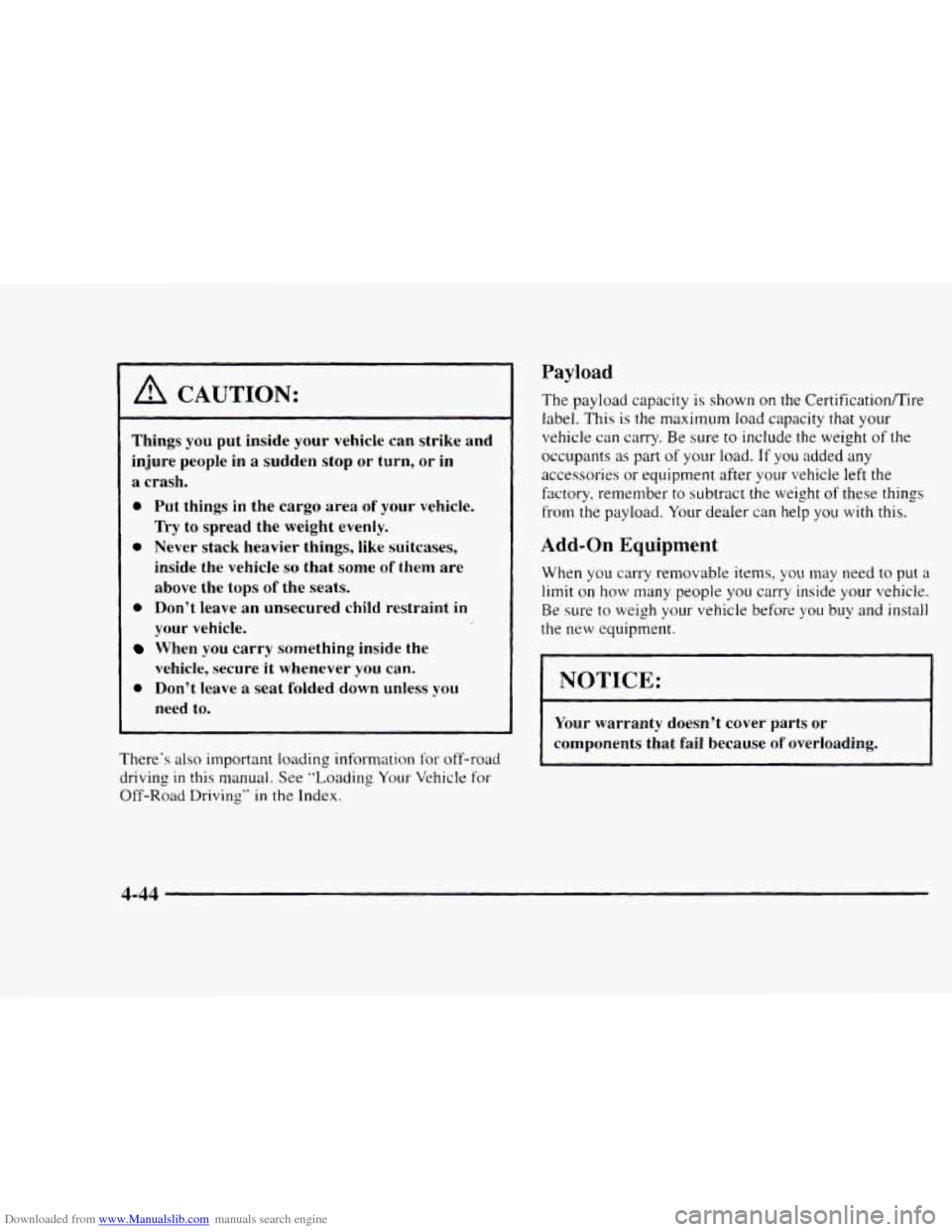
Downloaded from www.Manualslib.com manuals search engine ~ A CAUTION: ~
~
Things you put inside your vehicle can strike and
~ injure people in a sudden stop or turn, or in
1 a crash.
~ Try to spread the weight evenly.
~ 0 Never stack heavier things, like suitcases,
0 Put things in the cargo area of your vehicle.
inside the vehicle
so that some of them are
above the tops of the seats.
0 Don't leave an unsecured child restraint in
When you carry something inside the
vehicle, secure it whenever
you can.
0 Don't leave a seat folded down unless you
need to.
~ your vehicle.
There's also important loading information
lor off-road
driving
in this manual. See "Loading Your Vehicle for
Off-Road Driving" in the Index.
Payload
The payload capacity is shown on the Certificationflire
label.
This is the maximum load capacity that your
vehicle
can carry. Be sure to include the weight of the
occupants as part
of your load. If you added any
accessories or equipment after your vehicle
left the
factory, remember
to subtract the weight of these things
from
the payload. Your dealer can help you with this.
Add-on Equipment
When you carry removable items, you may need to put a
limit on how many people you carry inside your vehicle.
Be sure to weigh your vehicle before ~OLI buy and install
the new equipment.
NOTICE:
Your warranty doesn't cover parts or
components that fail because of overloading.
L
4-44
Page 208 of 402
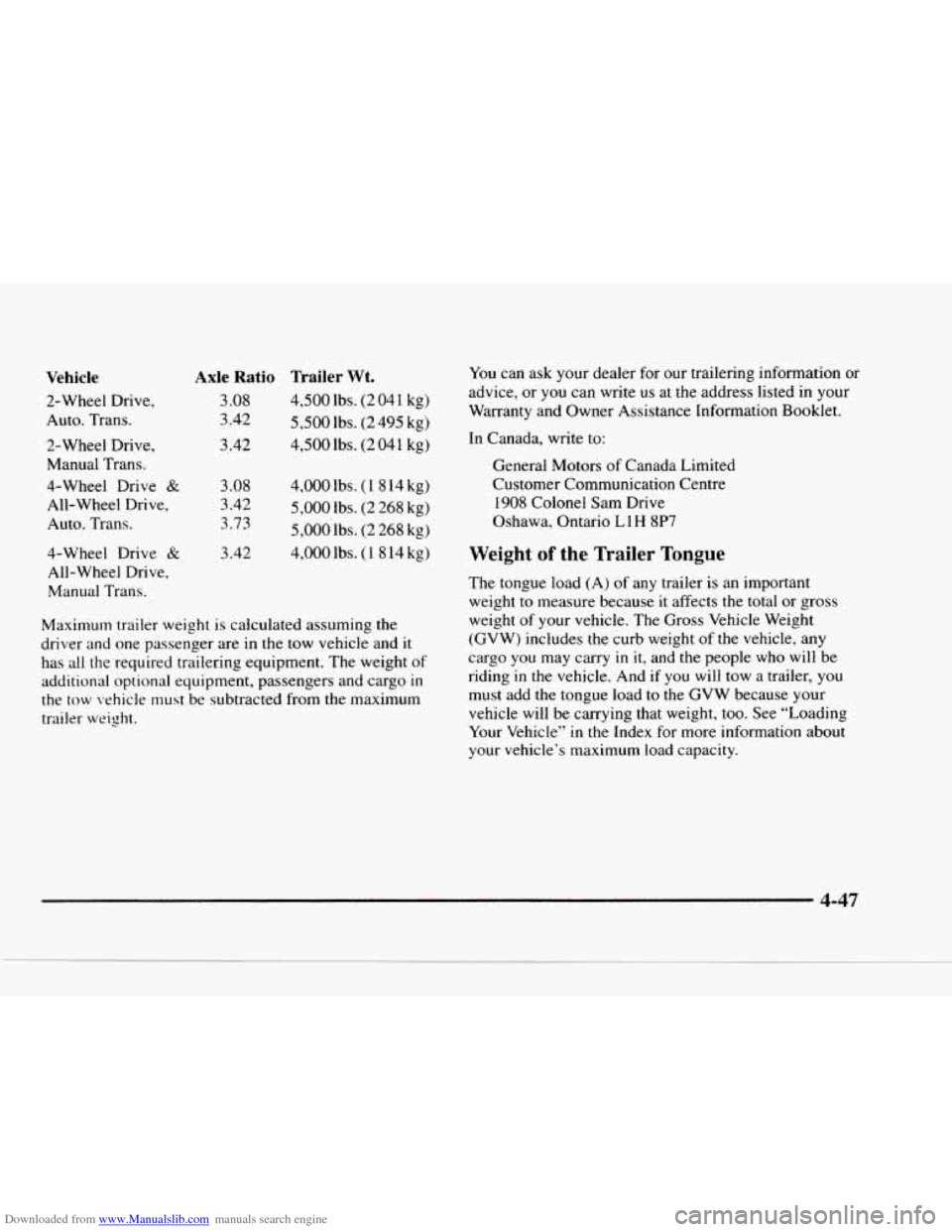
Downloaded from www.Manualslib.com manuals search engine Vehicle
2-Wheel Drive,
Auto. Trans.
2-Wheel Drive,
Manual Trans.
4-Wheel Drive
&
All-Wheel Drive,
Auto. Trans.
4-Wheel Drive
&
All-Wheel Drive, Manual Trans.
Axle Ratio Trailer Wt.
3 .OS 4,500 lbs. (2 04 1 kg)
3.42
5,500 lbs. (2 495 kg)
3.42 4,500 lbs. (2
04 1 kg)
3.08
3.42 3.73
3.42
4,000 lbs. (1 8 14 kg)
5,000 lbs. (2 268 kg)
5,000’1bs.
(2 268 kg)
4,000 lbs. (1 8 14 kg)
Maximum trailer weight is calculated assuming
the
driver and one passenger are in the tow vehicle and it
has all the required trailering equipment. The weight of
additional optional equipment, passengers and cargo in
the tow vehicle must be subtracted from the maximum
trailer weight. You
can ask your dealer for our trailering information or
advice, or you
can write us at the address listed in your
Warranty and Owner Assistance Information Booklet.
In Canada, write to:
General Motors
of Canada Limited
Customer Communication Centre
1908 Colonel Sam Drive
Oshawa, Ontario L
1 H 8P7
Weight of the Trailer Tongue
The tongue load (A) of any trailer is an important
weight to measure because it affects the total or gross
weight of your vehicle. The Gross Vehicle Weight
(GVW) includes the curb weight of the vehicle, any
cargo
you may carry in it, and the people who will be
riding in
the vehicle. And if you will tow a trailer, you
must add the tongue load to the GVW because your
vehicle will be carrying that weight, too. See “Loading
Your Vehicle”
in the Index for more information about
your vehicle’s maximum load capacity.
4-47
Page 265 of 402
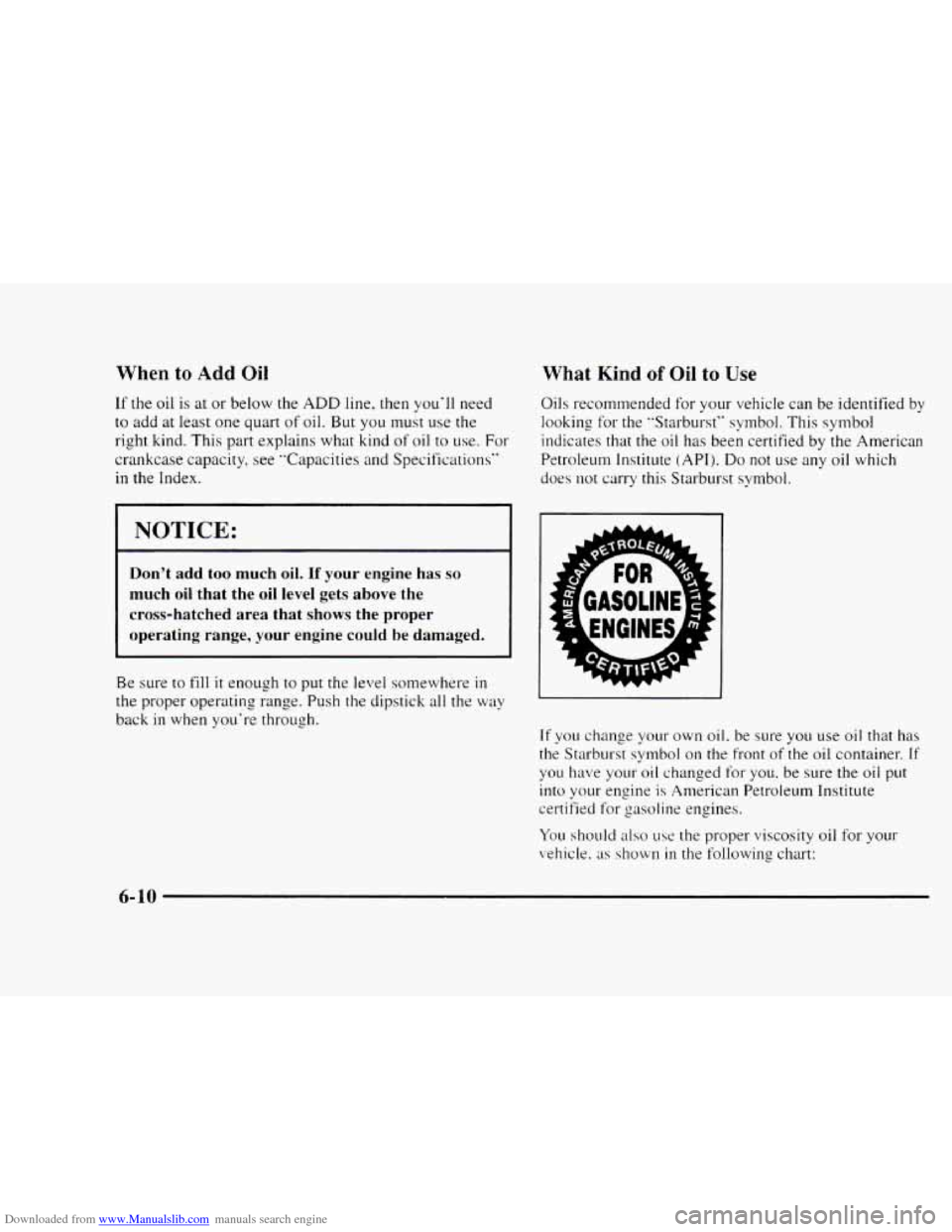
Downloaded from www.Manualslib.com manuals search engine When to Add Oil
If the oil is at or below the ADD line. then you'll need
to add at least one quart of oil. But you must use the
right kind. This part explains what kind
of oil to use. For
crankcase capacity, see "Capacities and Specifications"
in the Index.
NOTICE:
Don't add too much oil. If your engine has so
much oil that the oil level gets above the
cross-hatched area that shows the proper
operating range, your engine could be damaged.
Be sure to fill it enough to put the level somewhere in
the proper operating range. Push the dipstick all the way
back
in when you're through.
What Kind of Oil to Use
Oils recommended for your vehicle can be identified by
looking for the "Starburst" symbol. This symbol
indicates that
the oil has been certified by the American
Petroleunl Institute
(API). Do not use any oil which
does not carry
this Starburst symbol.
If you change your own oil. be sure you use oil that has
the Starburst symbol
on the front of the oil container. If
you have your oil changed for you, be sure the oil put
into your engine is American Petroleum Institute
certified for gasoline engines.
You should
also use the proper viscosity oil for your
vehicle. as
shown in the following chart:
6- 10
Page 302 of 402
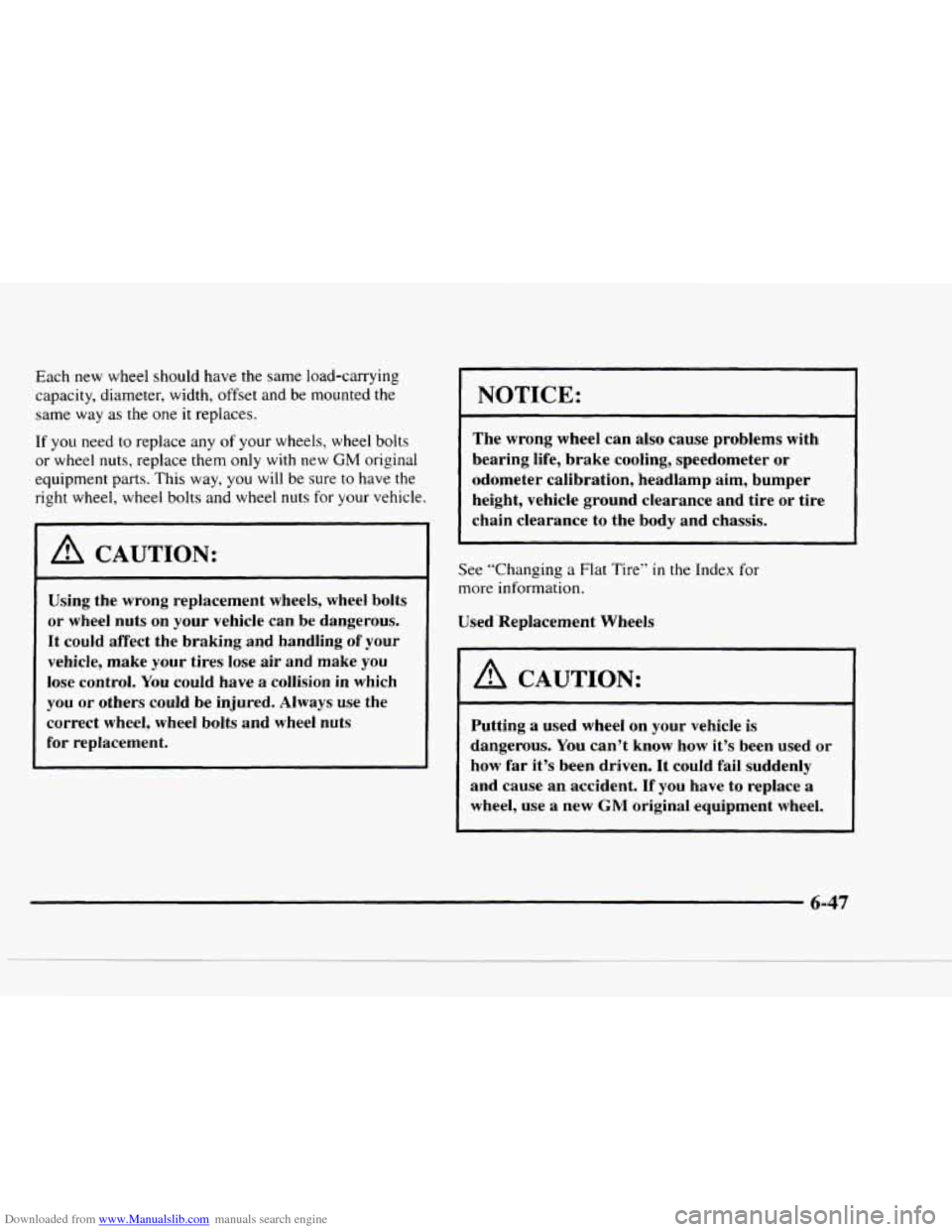
Downloaded from www.Manualslib.com manuals search engine Each new wheel should have the same load-carrying
capacity, diameter, width,
offset and be mounted the
same way as the one it replaces.
If you need to replace any of your wheels, wheel bolts
or wheel
nuts, replace them only with new GM original
equipment parts. This way, you will be sure
to have the
right wheel, wheel bolts and wheel nuts for your vehicle.
I A CAUTION:
NOTICE:
The wrong wheel can also cause problems with
bearing life, brake cooling, speedometer or
odometer calibration, headlamp aim, bumper
height, vehicle ground clearance and tire
or tire
chain clearance to the body and chassis.
Using the wrong replacement wheels, wheel bolts
or wheel nuts
on your vehicle can be dangerous.
It could affect the braking and handling of your
vehicle, make your tires lose
air and make you
lose control. You could have a collision in which
you or others could be injured. Always use the
correct wheel, wheel bolts and wheel nuts
for replacement.
See “Changing a Flat Tire” in the Index for
more information.
Used ’Replacement Wheels
I A CAUTION:
Putting a used wheel on your vehicle is
dangerous. You can’t know how it’s been used or
how
far it’s been driven. It could fail suddenly
and cause an accident.
If you have to replace a
wheel, use a new
GM original equipment wheel.
6-47